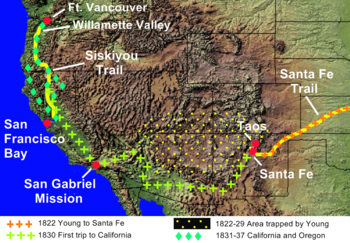Ewing Young
Ewing Young (1799 – February 9, 1841) was an American fur trapper and trader from Tennessee who traveled in what was then the northern Mexico frontier territories of Santa Fe de Nuevo México and Alta California before settling in the Oregon Country.
[1] In the early 1820s, he had moved to Missouri, then the far western edge of the American frontier, not far from the border of the Spanish-controlled territories of present-day Texas, New Mexico and the Southwestern United States.
At age 18, Young sold the farm he had recently purchased and eagerly signed up to join a somewhat larger group bound for Santa Fe.
Young and his associates established a commercial route between Nuevo México and Missouri that exchanged Mexican furs, horses and mules for American-produced trade goods.
[7] Once there, the group moved north to the Sacramento Valley, where they encountered Peter Skene Ogden of the Hudson's Bay Company (HBC).
After re-thinking, Young agreed to travel with Kelley and they set out in July 1834, with a group including Webley John Hauxhurst and Joseph Gale, both prominent figures in the Willamette Valley, accompanying them.
[8] Young and Kelley arrived at the Hudson's Bay Company post Fort Vancouver on October 17, 1834, center of the Columbia District.
Young decided to settle permanently on the west bank of the Willamette River, near the mouth of Chehalem Creek, opposite Champoeg.
[citation needed] The Mexican government of Alta California accused Young and his group of having stolen 200 horses when they left.
[11] In 1836, Young secured a vat from Nathaniel Jarvis Wyeth's failed post on Wapato Island and began a distillery to produce alcohol.
[12] The Methodist Mission superintendent Jason Lee organized the Oregon Temperance Society and, along with McLoughlin, tried to get Young to stop his efforts.
[11] Late in the year, U.S. Navy Lieutenant William A. Slacum arrived on the ship Loriot and helped to dissuade Young from following through on the venture.
[14] During the drive Gay and Bailey murdered a native boy, rationalizing it as justice for the attack two years earlier by the Rogue River Indians on Young’s group.
Perhaps in part to avoid these restrictions, Young was baptized a Catholic in 1830 (perhaps he also became a Mexican citizen and formalized his marriage to Maria Tafoya; however, if he did so, no record of these two events survives).
